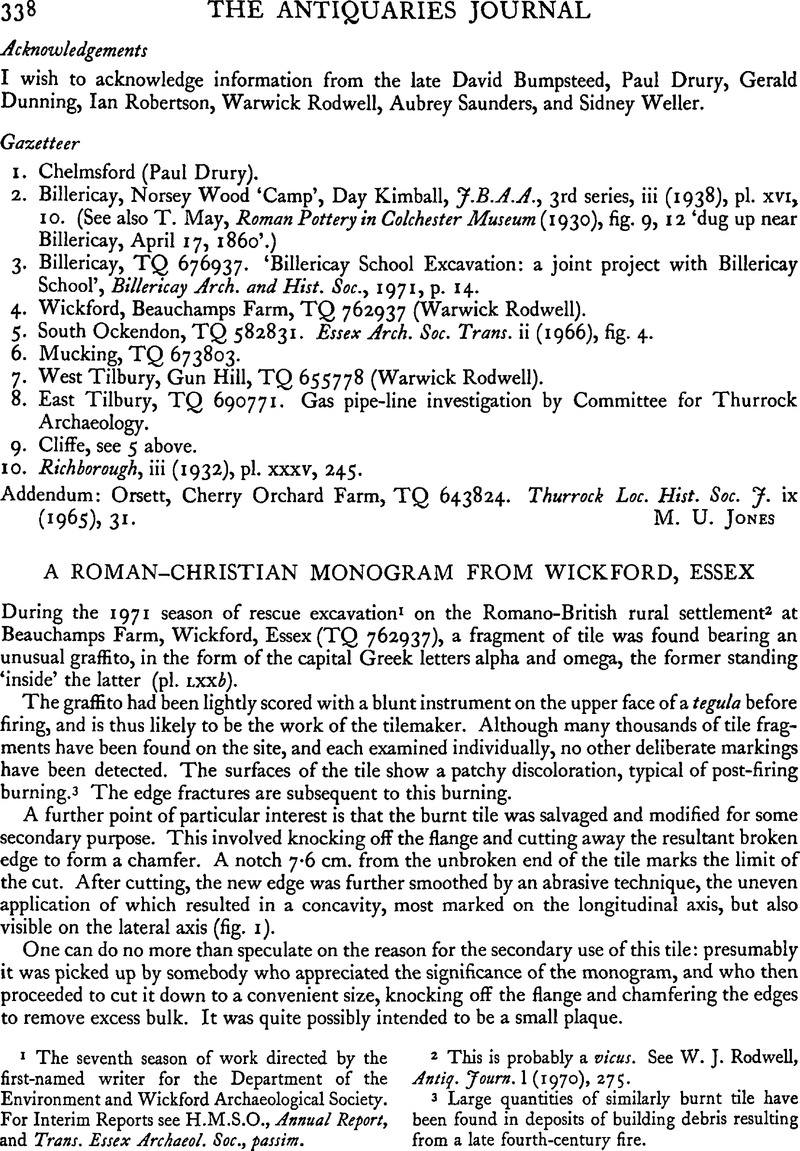Published online by Cambridge University Press: 29 November 2011

page 338 note 1 The seventh season of work directed by the first-named writer for the Department of the Environment and Wickford Archaeological Society. For Interim Reports see H.M.S.O., Annual Report, and Trans. Essex Archaeol. Soc, passim.
page 338 note 2 This is probably a vicus. See Rodwell, W. J., Antiq. Journ. 1 (1970), 275.Google Scholar
page 338 note 3 Large quantities of similarly burnt tile have been found in deposits of building debris resulting from a late fourth-century fire.
page 339 note 1 J.R.S., xxxix (1949), 115, no. 10.Google Scholar
page 339 note 2 Ibid., xxxvii (1947), 181, no. 11 (c), (d), (e), pl. XVI, 3–5; British Museum, Guide Rom. Brit. (3rd ed. 1964), p. 40, nos. 37–9, pl. VIII, 38.
page 339 note 3 J.R.S., xxxiii (1943), p. 80Google Scholar, pl. VIII; Kraay, , Antiq. Journ. xxii (1942), 219CrossRefGoogle Scholar, pl. XXX; B.M., Guide Rom. Brit., p. 60, fig. 30, 3.
page 340 note 1 Britannia, i (1970), 312, no. 29 (a)-(c), pl. XXXVIIIbGoogle Scholar; Painter, , British Museum Quarterly, xxxiii (1969)131–43, fig. 9, pl. LXVIa.Google Scholar
page 340 note 2 Thompson, E. Maunde, Introduction to Greek and Latin Palaeography (Oxford, 1912), pp. 3, 196, shows that the cursive form, like to, became dominant in texts from the third century B.C.Google Scholar
page 340 note 3 Dr. Jocelyn M. C. Toynbee kindly discussed with the present writer the dating and significance of these letter-forms, and supplied the references given in the next two footnotes.
page 340 note 4 Papathanasopoulos, Athens Annals of Archaeology, ii (1969), 15, pl. 1. The composition shows a ten-spoked wheel with Apollo's lyre and name at the centre and each of the nine Muses in one of the radial panels.Google Scholar
page 340 note 5 Toynbee, Jocelyn M. C., Papers of the British School at Rome, xvi (1948), 34, pl. IX, fig. 25. There are five instances of this letter in ll. 16, 17.Google Scholar
page 340 note 6 Cabrol-Leclercq, , Dictionnaire d'archéologie chrétienne et de liturgie (Paris, 1924), iii, col. 6.Google Scholar
page 340 note 7 Hübner, E., Inscriptions Hispaniae Christianae (Berlin, 1871), no. 151 (near Pamplona), no. 197 on a tile (Puente Genil) (also C.I.L., ii, 4967, 36).Google Scholar